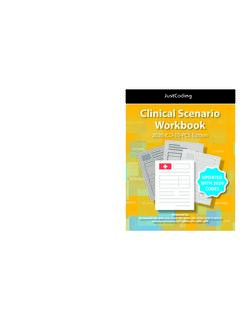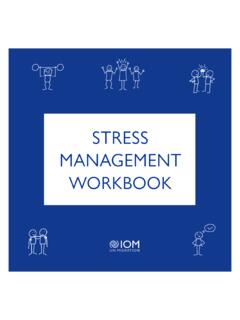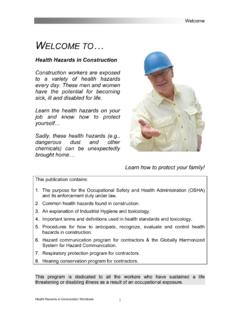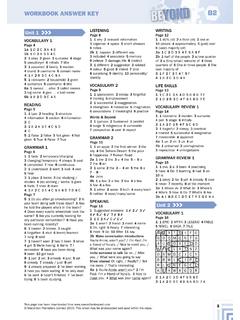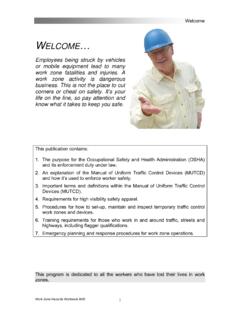Transcription of S.M.A.R.T. Goals Workbook - Decision Skills
1 Goals Workbook By Dr. Richard Feenstra August 2016 Goals Workbook 2 Table of Contents I. Statement of Purpose .. 3 II. Eight Shirts and a Laptop .. 3 III. How to Use this Workbook .. 3 IV. The Model .. 4 V. Specific .. 4 VI. Measurable .. 5 VII. Actionable .. 7 VIII. Relevant .. 9 IX. Time Bound .. 10 X. Summary .. 12 XI. Additional Material .. 13 XII. Guide and Worksheets .. 14 Goals Workbook 3 Statement of Purpose As the title suggests, this is a Workbook . More specifically, it is a Workbook you can use to learn about and harness the power of SMART Goals . Still, telling you what it is, is different than telling you the purpose it serves. Why should you commit time and resources to learn how to use this Workbook ?
2 This Workbook was created to help you better structure your Goals so that you can accomplish more in less time, so that you are more efficient, more focused, and more productive. It is the purpose of this short book to provide you a proven way to achieve more success. Before moving on, I want to point out that this is not necessarily an easy process. The term work is part of Workbook . When I first started using the SMART format to pursue my Goals it took me several hours that turned into a few days to really work through which Goals were most relevant. Then it took me more time to figure out how I wanted to go about achieving success, establishing my sub- Goals and my next actions.
3 A few years later, I now review my Goals once a week and it only takes me 30 minutes, no more than an hour to update my progress. Eight Shirts and a Laptop At the end of 2011, I decided to sell everything and live a mobile lifestyle. Since then I have lived in Colombia, Ecuador, Peru, Vietnam, the Philippines, and India. In 2015, I spent a couple of months traveling through Greece, Italy, Spain, and Portugal. My current adventure has taken me to China for 4 months. I have now visited over 30 countries and my list continues to grow. It has been a tremendous experience. Since 2011, I have lived out of a carry-on bag and a personal bag. My carry-on has my eight shirts, and my personal bag I call, The Office.
4 Travel has not been my only goal. As an educational psychologist, I now have over 20,450 students from 164 countries around the world. I have learned Spanish and have successfully learned several new skillsets that have helped me grow both personally and professionally. So far this year, I have read 16 books. This Workbook was a small, short-term goal accomplished using SMART. While certainly SMART is not the only way to achieve what you want, it has definitely worked for me. And while certainly success is a relative concept, I hope my story is at least slightly inspiring for anyone that wants to achieve more in less time. How to Use this Workbook If you are not familiar with SMART Goals , then I suggest reading the Workbook from start to finish.
5 Once finished, use the worksheets to establish your Goals step-by-step. On the other hand, if you are already familiar with the SMART model, even if the model you used is a different variation than the one presented here, you can Goals Workbook 4 probably go straight to the worksheets while using the Workbook more as a reference. The Model George T. Doran, is generally credited with the original development of the SMART model in a 1981 paper that he published in the journal Management Review , titled "There's a Way to Write Management's Goals and Objectives". In the original version, Doran defined SMART as: 1. Specific: target a specific area for improvement. 2. Measurable: quantify, or at least suggest, an indicator of progress.
6 3. Assignable: specify who will do it. 4. Realistic: state what results can realistically be achieved. 5. Time-related: specify when the result can be achieved. Since the original format a wide range of other variants have surfaced. The most common use the A as achievable and some versions extend the model to include an E and an additional R to form SMARTER Goals . The second R is most often used to refer to resources, asking the individual to consider to what extent the resources are available to achieve the goal. In this Workbook , a version of SMART is used that addresses the reality that in life we most often are in pursuit of multiple Goals , not a single goal in isolation.
7 In order to address this aspect of goal setting, the format discussed is: 1. Specific: be precise in what you want to achieve. 2. Measurable: quantify performance and outcomes. 3. Actionable: state next actions and milestones. 4. Relevant: determine priorities. 5. Time Bound: develop feedback loops and time lines. Specific Many times when people are asked, What are your top Goals in life? Common responses include to be healthy, wealthy, happy, to travel the world, or to write the next great novel. While these responses are Goals , they are not specific. In fact, they are so general that they are more appropriately defined as visions of some mental picture of an ideal future state.
8 And while it is good to have vision, research has shown when it comes to actual achievement of a goal, being specific is important. In over 400 laboratory and field studies, it has been demonstrated repeatedly that specific, challenging Goals lead to a higher level of achievement than easy Goals that are vague or abstract, telling a person to do one's best. The underlying theory is that when a goal is specific, this provides clarity, helping when it comes to Goals Workbook 5 mentally constructing a plan for success and providing motivation for some individuals. In being specific, you need to define your Goals in terms of the precise result you want to achieve. If you cannot be exact, then at least a range.
9 For instance, what does it mean to have a goal to be healthy or wealthy? These are subjective Goals that lack definition. Is being a millionaire even considered wealthy anymore? What about health? For most, being healthy means being capable of a certain physical activity such as running a marathon or being a certain weight. Therefore, if your vision is to be healthy, set a goal like run two miles in under 15 minutes or get your body mass index (BMI) to twenty. Generally speaking, the more specific you can make a goal the better. The more specific, the easier it becomes to establish other aspects of the goal. The less specific your Goals , the more difficult it will be to measure success, to determine the actions you need to take, to figure out how one goal relates to another and to establish time boundaries.
10 Measurable This is arguably my favorite part of goal setting and an area where I think it is easy to get off track by establishing measurements that are less than helpful. In fact, I think in our digital world getting off track is easier than any other time in history. The most common error I see is establishing measurements that track results, but not performance. I think in order to obtain the best results you should try to use both. The second most common error is allowing the way you decide to measure to drive your goal instead of the goal driving the way you measure. Last, I want to cover the concept of triangulation, discussing when and why you might want to use multiple measurements.


